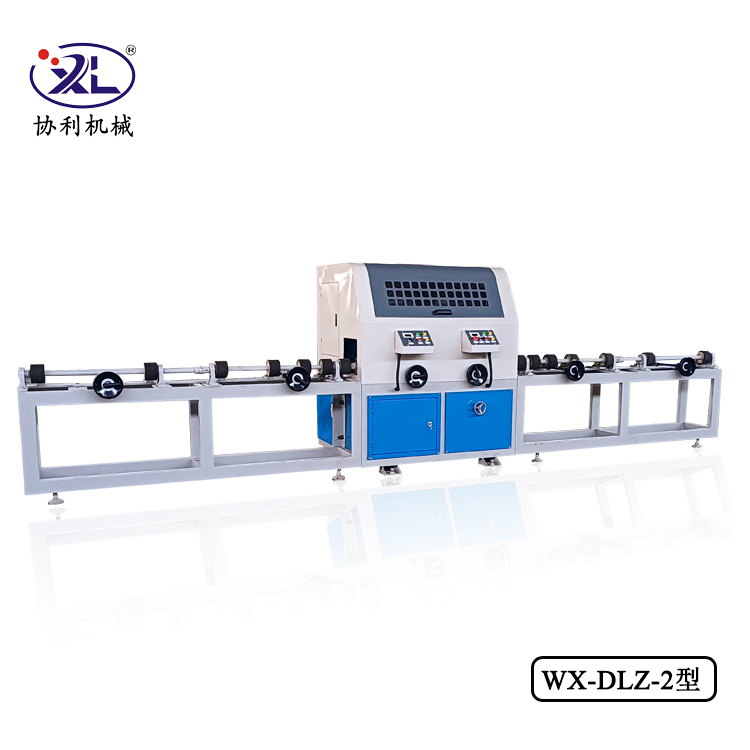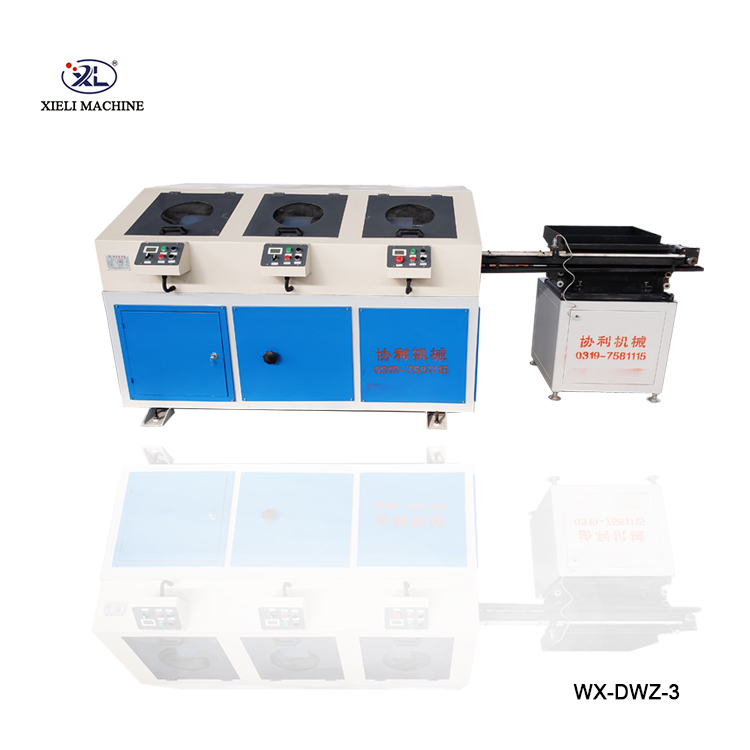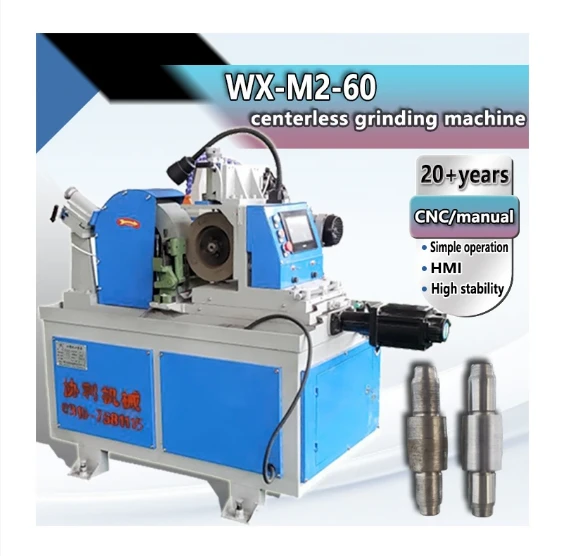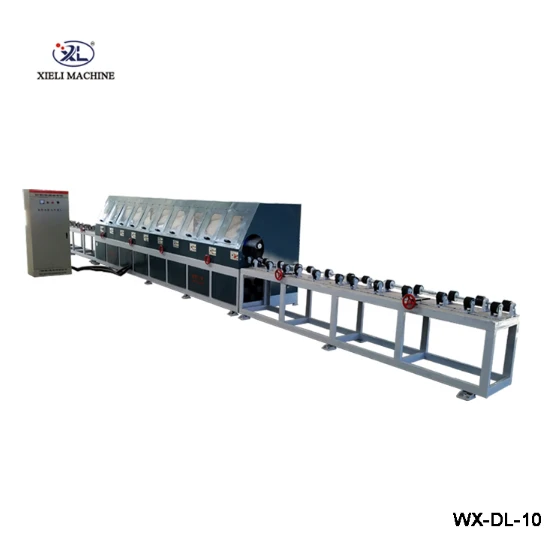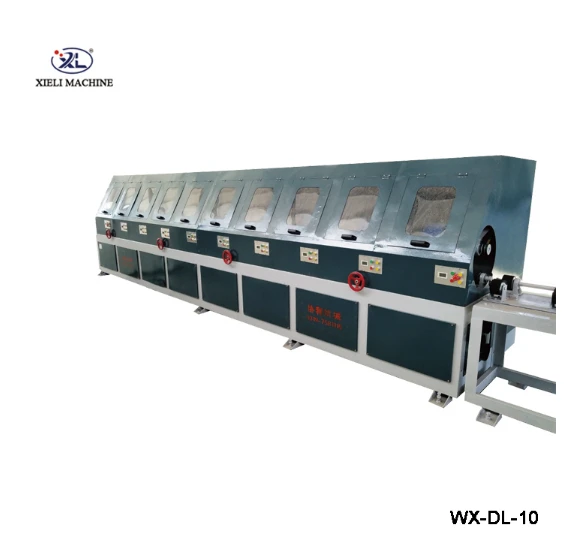The Imperative of Precision: An In-Depth Look at Tube Polishing Technology in Modern Manufacturing
In today's highly competitive industrial landscape, the pursuit of superior surface finish and dimensional accuracy is not merely an aesthetic choice but a critical determinant of product performance, longevity, and operational efficiency across a myriad of sectors. The significance of surface integrity in components, especially tubular structures, cannot be overstated, as it directly impacts properties such as corrosion resistance, fluid flow dynamics, hygiene standards, and structural fatigue life. This comprehensive exploration delves into the sophisticated world of tube polishing technology, with a particular focus on the advanced capabilities of the tube polishing machine. These specialized machines are engineered to transform raw, untreated pipes and tubes into highly polished components, meeting the stringent demands of industries ranging from petrochemical and pharmaceutical to food processing and aerospace. The evolving industry trends emphasize automation, sustainability, and unparalleled precision, moving beyond conventional abrasive techniques to embrace high-efficiency, multi-stage polishing systems that minimize material waste and energy consumption while maximizing output quality. The meticulous control over surface roughness (Ra), which can be reduced to sub-micron levels, significantly enhances the functional characteristics of tubes, preventing microbial growth in sterile environments, reducing friction in fluid transport, and improving the adhesion of protective coatings. As global supply chains demand increasingly higher quality and faster turnaround times, manufacturers are compelled to invest in cutting-edge polishing solutions that integrate advanced sensor technologies, robotic handling, and adaptive polishing algorithms to ensure consistent, defect-free surfaces on a diverse range of materials, including stainless steel, titanium, copper alloys, and specialized superalloys. This strategic investment in advanced tube polishing technology underscores a commitment to innovation, operational excellence, and adherence to global quality benchmarks such as ISO 8501-1 for surface preparation standards, which dictate acceptable levels of cleanliness and roughness for various applications. The ability to precisely control the polishing process, from coarse grinding to mirror-like finishes, allows manufacturers to meet bespoke client specifications and gain a significant competitive edge in markets where surface quality is paramount for product safety, reliability, and brand reputation. Furthermore, the integration of real-time monitoring systems and data analytics enables predictive maintenance and process optimization, ensuring sustained peak performance and minimizing costly downtime, thereby optimizing the overall total cost of ownership (TCO) for these sophisticated industrial assets.
The Auto Steel Pipe Tube Outer Wall Polishing Machine: Engineering Excellence and Technical Specifications
The Auto Steel Pipe Tube Outer Wall Polishing Machine represents the pinnacle of automated surface finishing technology, designed to deliver exceptional results on a wide array of metallic tubes and pipes. This highly specialized equipment, developed by leading tube polishing machine manufacturers, is engineered for robustness, precision, and efficiency, making it an indispensable asset in modern industrial production lines. At its core, the machine utilizes a series of abrasive belts or polishing wheels, meticulously arranged to progressively refine the outer surface of tubes. The design typically incorporates multiple polishing heads, each equipped with different grit sizes, allowing for a multi-stage process that systematically removes imperfections, scratches, and oxidation layers, culminating in a uniformly smooth and reflective finish. Key technical parameters include its processing capacity, which often spans a broad range of pipe diameters, typically from 10mm to 200mm, and lengths up to 12 meters, accommodating both small and large-scale industrial requirements. The processing speed is adjustable, ranging from 0.5 to 10 meters per minute, depending on the desired finish and material hardness, ensuring optimal throughput without compromising quality. Power consumption for such machines usually falls within the 15 kW to 75 kW range, reflecting their industrial-grade capabilities, while the operational voltage is typically 380V/50Hz/3 phase, standard for heavy machinery. The machine's frame is constructed from high-strength structural steel, often Q235 or Q345, providing exceptional rigidity and vibration dampening, crucial for maintaining precision during high-speed operations. Surface treatment of the frame includes shot blasting and anti-corrosion painting, ensuring longevity in harsh industrial environments. The drive system typically employs precision gears or belt drives powered by high-torque electric motors, integrated with frequency converters (VFDs) to allow for variable speed control, which is essential for optimizing the polishing process for different materials and desired surface finishes. Furthermore, the integration of advanced sensors, such as laser displacement sensors or eddy current sensors, allows for real-time monitoring of tube eccentricity and surface quality, providing immediate feedback for process adjustments and ensuring consistent results. The control system, often based on a Programmable Logic Controller (PLC) with a Human-Machine Interface (HMI) touchscreen, offers intuitive operation, fault diagnosis, and data logging capabilities, enabling operators to easily set parameters, monitor progress, and troubleshoot issues. This sophisticated automation minimizes manual intervention, reduces labor costs, and significantly enhances operational safety by isolating operators from moving parts and abrasive materials. The machine's design also prioritizes maintenance accessibility, with modular components and clearly marked service points, facilitating quick abrasive belt changes and routine inspections, thereby reducing downtime and maximizing productivity.
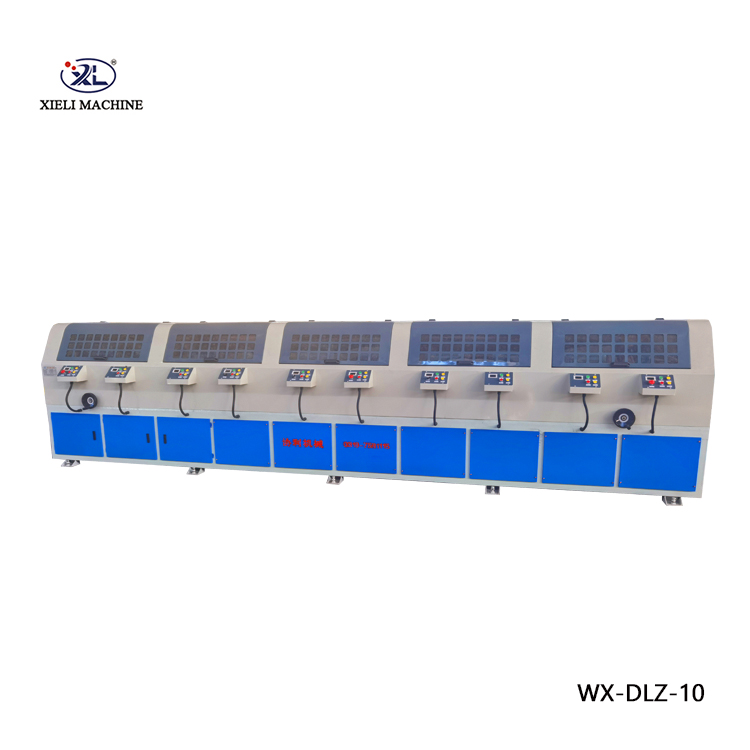
A critical aspect of the Auto Steel Pipe Tube Outer Wall Polishing Machine's design is its adherence to robust engineering principles and internationally recognized standards, ensuring both performance and safety. The core mechanical components, such as the polishing spindles, guide rollers, and material handling systems, are manufactured from high-grade alloy steels, often undergoing precise CNC machining, heat treatment, and surface hardening (e.g., nitriding or carburizing) to enhance wear resistance and extend operational lifespan. For instance, critical bearings are typically sourced from reputable manufacturers like SKF or FAG, guaranteeing smooth operation and minimal friction. Electrical components, including motors, contactors, and circuit breakers, comply with IEC (International Electrotechnical Commission) standards, providing reliable and safe power management. The machine's pneumatic systems, essential for clamping mechanisms and polishing head pressure control, often utilize components from industry leaders like SMC or Festo, ensuring precise and responsive actuation. The entire system is designed to meet or exceed relevant ISO (International Organization for Standardization) standards for machinery safety (e.g., ISO 12100 for safety of machinery – general principles for design) and quality management (ISO 9001 for manufacturing processes). Furthermore, for markets requiring specific certifications, these machines are often designed to comply with CE marking directives for European conformity or UL standards for North America, underscoring their global applicability and adherence to diverse regulatory frameworks. The precision of the polishing process is often quantified by the resulting surface roughness, measured in Ra (arithmetic average roughness). While raw tubes may have an Ra value of several microns (e.g., 2.0-5.0 µm), this machine is capable of reducing it to significantly lower levels, typically ranging from 0.8 µm down to 0.1 µm or even finer mirror finishes, depending on the abrasive sequence and material. This level of control is paramount for applications where surface finish directly impacts product functionality, such as in ultra-high purity gas lines or medical implants. The material feeding system is often equipped with V-groove rollers or driven conveyor belts, designed to prevent marring or scratching the tube surface during transport, and integrated with automatic tube clamping mechanisms that ensure consistent pressure and alignment throughout the polishing cycle. The abrasive belt tensioning system is also critical, often pneumatically or hydraulically controlled, to maintain optimal contact pressure between the abrasive and the tube, ensuring even material removal and uniform surface quality. These meticulous engineering details and adherence to stringent quality control protocols collectively ensure that the Auto Steel Pipe Tube Outer Wall Polishing Machine not only meets but exceeds the exacting demands of modern industrial polishing applications, providing a reliable and high-performance solution for achieving superior tube surface finishes.
Manufacturing Process and Quality Assurance: The Foundation of Reliable Tube Polishing Machines
The creation of a high-performance pipe tube polisher begins long before the final assembly, rooted in a rigorous manufacturing process that emphasizes material selection, precision engineering, and comprehensive quality assurance. The foundation of these machines relies on robust structural components, typically fabricated from high-grade carbon steel or specialized alloy steels, selected for their superior strength, rigidity, and fatigue resistance. Initial material preparation often involves advanced techniques such as laser cutting or plasma cutting to achieve precise dimensions for frame components and housing elements, followed by meticulous welding processes (e.g., MIG or TIG welding) executed by certified professionals to ensure structural integrity and stability, critical for minimizing vibration during high-speed polishing operations. For certain critical parts, such as complex gearboxes or specialized housing components, methods like casting or forging are employed to create intricate shapes with enhanced material properties. Casting, often utilizing sand or investment casting techniques for ferrous and non-ferrous alloys, provides excellent design flexibility for complex geometries, while forging offers superior grain structure and mechanical strength, particularly vital for highly stressed parts like shafts and spindles within the polishing heads. Subsequent to initial fabrication, these components undergo extensive CNC (Computer Numerical Control) machining processes, including milling, turning, and grinding, to achieve micron-level tolerances, ensuring perfect alignment and smooth operation of all moving parts. This precision machining is paramount for achieving consistent polishing results and extending the lifespan of the machine. The selection of materials for wear-prone components, such as guide rollers and polishing head housings, often includes hardened tool steels or specific grades of stainless steel, sometimes further enhanced with surface treatments like nitriding or chrome plating to boost resistance against abrasion and corrosion, particularly when handling abrasive slurries or working in humid environments. The electrical control cabinet, housing the PLC, VFDs, and other sensitive electronics, is typically constructed from high-quality sheet metal, sealed to IP54 or IP55 standards to protect against dust and splashing water, ensuring reliable operation in industrial settings.
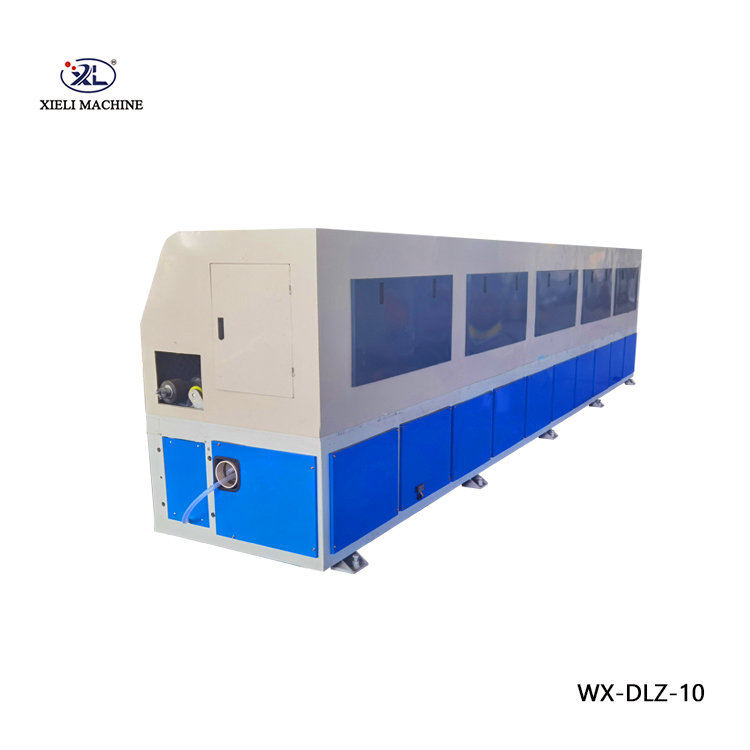
Beyond the meticulous manufacturing, adherence to stringent quality control and testing standards is what truly distinguishes a reliable tube polishing machine. Every stage of the manufacturing process, from raw material reception to final assembly, is subject to rigorous inspection protocols. Incoming materials are verified against material certificates (e.g., EN 10204 3.1) to ensure chemical composition and mechanical properties meet specifications. During fabrication, non-destructive testing (NDT) methods like ultrasonic testing (UT) or magnetic particle inspection (MPI) are routinely applied to welds to detect any internal defects, ensuring structural integrity. Dimensional accuracy of machined parts is verified using Coordinate Measuring Machines (CMMs) and precision gauges, guaranteeing interchangeability and optimal fit. Electrical systems are tested for insulation resistance, grounding continuity, and functional safety in accordance with standards like NFPA 79 for industrial machinery. The assembled machine undergoes a comprehensive series of factory acceptance tests (FAT), simulating real-world operating conditions. These tests evaluate key performance metrics such as polishing efficiency, surface roughness reduction, dimensional consistency, noise levels, and energy consumption. For example, a batch of tubes of varying diameters and materials might be run through the machine, and their surface finishes measured using profilometers to confirm they meet specified Ra values and are free of defects like spiraling or streaking. The machine's operational lifespan is critically dependent on these foundational manufacturing and testing practices; a well-built machine, maintained according to manufacturer guidelines, can reliably serve for 15 to 20 years or more, representing a significant return on investment. Furthermore, compliance with international standards such as ISO 9001 (Quality Management Systems), ISO 14001 (Environmental Management Systems), and ISO 45001 (Occupational Health and Safety Management Systems) reflects a manufacturer's holistic commitment to quality, environmental responsibility, and worker safety. The integration of advanced diagnostics and predictive maintenance features, often leveraging IoT (Internet of Things) sensors, further extends the machine's effective lifespan by enabling proactive intervention before minor issues escalate into major failures, optimizing the Total Cost of Ownership (TCO) over the equipment's long operational life. This meticulous attention to detail throughout the manufacturing and quality assurance phases ensures that the resulting tube polishing machine is not just a piece of equipment, but a robust, reliable, and high-performance solution capable of meeting the most demanding industrial requirements, contributing significantly to a company's productivity and product quality objectives.
Applications and Industry Benefits: Where Precision Polishing Makes a Difference
The versatility and precision of the Auto Steel Pipe Tube Outer Wall Polishing Machine make it an indispensable tool across a vast spectrum of industrial applications, delivering substantial benefits in terms of product quality, operational efficiency, and regulatory compliance. In the petrochemical industry, where pipes are critical for transporting highly corrosive or volatile fluids, a superior internal and external surface finish is paramount. Polished surfaces significantly reduce the adhesion of scale, sludge, and paraffin waxes, thereby minimizing fouling, extending pipeline lifespan, and reducing the frequency of costly cleaning operations. This translates directly into enhanced fluid flow, reduced pressure drop, and substantial energy savings due to decreased pumping requirements, aligning with the industry's drive for operational sustainability and reduced carbon footprint. The improved corrosion resistance of polished stainless steel and alloy tubes prevents pitting and stress corrosion cracking, which are major failure mechanisms in aggressive chemical environments, ensuring greater safety and reliability of infrastructure. Similarly, in the metallurgical industry, polished tubes are essential for applications requiring high dimensional accuracy and aesthetic appeal, such as decorative architectural elements, furniture, and automotive components. The removal of surface defects like drawing marks, annealing scales, and weld seams not only enhances visual appeal but also prepares the surface for subsequent coatings, plating, or painting, ensuring superior adhesion and extended coating life. For industries like food processing, dairy, and pharmaceuticals, where hygiene is non-negotiable, the ability to achieve ultra-smooth, crevice-free surfaces is critical. Polished stainless steel tubes with a roughness average (Ra) of 0.4 µm or less prevent the proliferation of bacteria and biofilms, facilitating efficient Clean-in-Place (CIP) and Sterilize-in-Place (SIP) operations. This directly contributes to product safety, prevents cross-contamination, and ensures compliance with stringent health regulations, such as FDA and EHEDG guidelines, safeguarding public health and brand reputation.
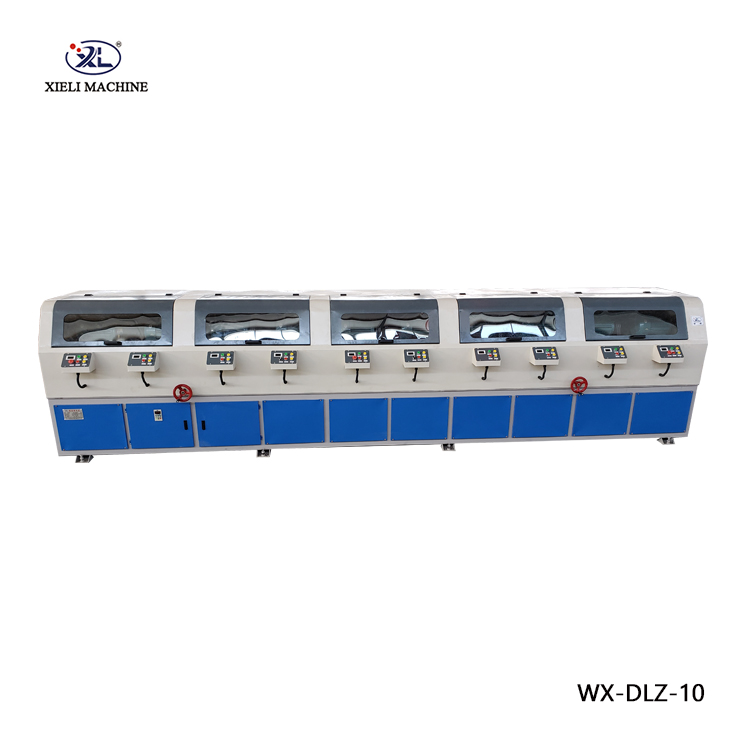
Beyond these core sectors, the benefits extend to water supply and drainage systems, where polished pipes reduce friction, prevent mineral buildup (limescale), and enhance the efficiency of fluid transport, contributing to overall energy conservation within municipal and industrial water networks. In power generation, including conventional and nuclear power plants, highly polished boiler tubes and heat exchanger tubes optimize heat transfer efficiency and resist scaling, thereby improving energy output and extending the operational life of critical components. The aerospace industry relies on flawlessly polished tubes for hydraulic systems and structural components, where surface integrity directly impacts fatigue life and reliability under extreme operating conditions. Furthermore, the semiconductor industry demands ultra-high purity (UHP) tubing with internal surface finishes down to Ra 0.25 µm or even 0.1 µm for gas delivery systems, preventing particulate contamination that can compromise wafer fabrication. The consistent high-quality finish achieved by an advanced tube polishing machine translates into several tangible advantages for manufacturers. Firstly, the enhanced corrosion resistance significantly extends the service life of components, reducing the need for premature replacements and associated maintenance costs. Secondly, the reduction in fluid friction and prevention of material buildup lead to substantial energy savings in pumping and filtration systems, aligning with global sustainability goals. Thirdly, for applications requiring hygiene, the ease of cleaning and sterilization afforded by smooth surfaces ensures product purity and compliance with strict industry standards. Lastly, the superior aesthetic quality and consistent finish improve product marketability and brand perception, allowing companies to command higher prices for premium products. The automation inherent in these machines also significantly reduces manual labor, minimizing human error, increasing throughput, and ensuring a safer working environment by limiting operator exposure to abrasive materials and moving machinery. This strategic investment not only optimizes operational efficiency but also provides a distinct competitive advantage in markets where surface quality and long-term performance are critical differentiating factors for product success. The ability to meet highly specific surface finish requirements, such as those defined by ASME BPE (Bio Processing Equipment) standards for pharmaceutical and biotechnology applications, further solidifies the role of advanced tube polishing technology as a cornerstone of modern, high-precision manufacturing.
Advanced Features and Technological Edge: Redefining Tube Polishing Performance
The cutting-edge capabilities of contemporary tube polishing machines, particularly the Auto Steel Pipe Tube Outer Wall Polishing Machine, are defined by a suite of advanced features that collectively elevate performance, enhance precision, and optimize operational efficiency beyond traditional methods. One of the primary technological advantages lies in their multi-stage abrasive polishing system, often comprising 6 to 12 or more polishing heads arranged in series. Each head is equipped with progressively finer abrasive belts or specialized polishing wheels, allowing for a gradual material removal process that starts with coarse grinding to eliminate deep scratches and weld beads, transitions to intermediate finishing, and culminates in fine polishing for mirror-like surfaces. This sequential approach ensures exceptional surface uniformity and control over the final roughness average (Ra) value, which can be precisely controlled from 2.5 µm down to 0.1 µm or even lower depending on the application. The integration of highly sensitive sensors and real-time monitoring systems is another significant leap forward. Laser profilometers and eddy current sensors, for instance, continuously scan the tube surface during polishing, detecting and quantifying defects, variations in wall thickness, or inconsistencies in the polishing process. This data is fed back to the machine's PLC (Programmable Logic Controller) system, enabling adaptive control over polishing pressure, belt speed, and oscillation patterns, ensuring consistent results even on tubes with minor deformities or material variations. Furthermore, many advanced systems incorporate automatic compensation mechanisms that adjust polishing parameters based on abrasive wear, maximizing belt life and maintaining consistent abrasive performance without manual intervention. The adoption of robust and precise material handling systems, often incorporating V-groove rollers, hydraulic clamping, and automatic loading/unloading mechanisms, minimizes the risk of tube damage during transit and ensures seamless integration into automated production lines. These systems are designed to handle a wide range of tube dimensions, from small-diameter precision tubing to large industrial pipes, without compromising alignment or surface integrity. The use of high-efficiency motors, coupled with Variable Frequency Drives (VFDs), allows for precise control over rotational speeds and feed rates, enabling energy optimization tailored to specific material types and desired finish levels. This not only reduces energy consumption but also extends the lifespan of abrasive consumables by preventing excessive heat buildup and ensuring optimal material removal rates.
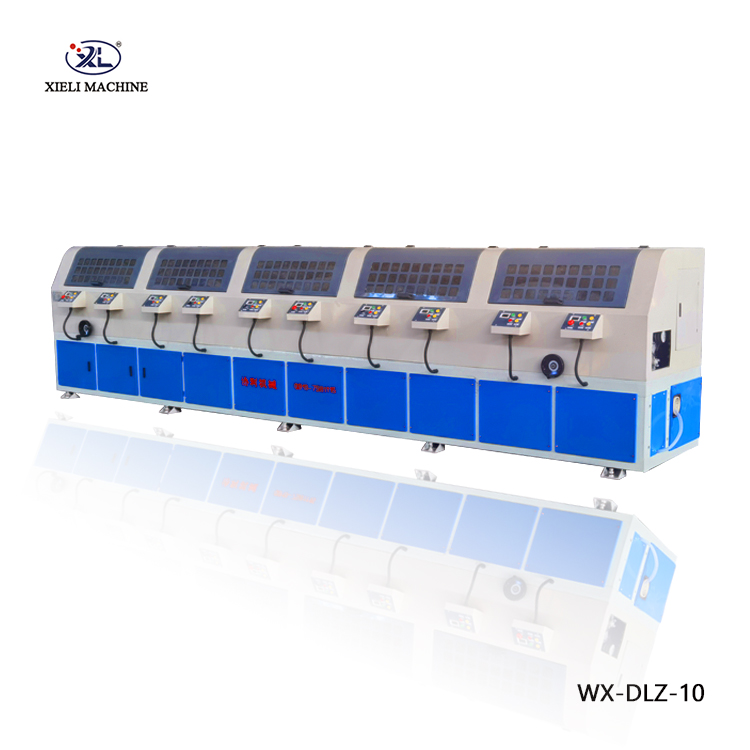
Beyond the core polishing functionality, modern tube polishing machine manufacturers often integrate features that enhance the overall operational efficiency and user experience. Intuitive Human-Machine Interfaces (HMIs) with touchscreen controls allow operators to easily program polishing recipes, monitor machine status, and troubleshoot issues, significantly reducing setup times and minimizing the learning curve. Advanced diagnostics and predictive maintenance capabilities, often leveraging Industrial Internet of Things (IIoT) sensors, collect data on motor temperatures, bearing vibrations, and belt tension, enabling proactive maintenance scheduling and preventing unscheduled downtime. This data-driven approach maximizes machine uptime and reduces operational costs. Moreover, environmental considerations are increasingly integrated into machine design. Closed-loop coolant filtration systems reduce water consumption and extend coolant life, while efficient dust collection systems capture abrasive particles, ensuring a cleaner and safer working environment and facilitating compliance with environmental regulations. The modular design of many contemporary polishing machines allows for easy scalability and customization, enabling manufacturers to add or remove polishing heads, integrate additional cleaning or drying stations, or modify the material handling system to meet evolving production demands or specific project requirements. For instance, some advanced systems incorporate automated wash and passivation stations post-polishing, ensuring that stainless steel tubes regain their passive layer, enhancing corrosion resistance and cleanliness, particularly vital for pharmaceutical and food-grade applications. The ability to polish a diverse range of materials, including stainless steel (304, 316L), carbon steel, brass, copper, aluminum, and even exotic alloys like Inconel or Hastelloy, further underscores the versatility of these machines, making them a cornerstone technology for various industries. By providing precise control over surface finish, minimizing material waste, optimizing energy consumption, and offering comprehensive automation features, these advanced tube polishing systems represent a significant investment that delivers substantial long-term returns through improved product quality, reduced operational costs, and enhanced competitive advantage in the global market. The continuous innovation in abrasive materials, polishing media, and control algorithms further propels the capabilities of these machines, ensuring they remain at the forefront of surface finishing technology.
Key Performance Parameters and Data Analysis: Quantifying Excellence
For B2B decision-makers and technical personnel, understanding the key performance parameters of a pipe tube polisher is crucial for evaluating its suitability for specific applications, forecasting operational costs, and benchmarking against competitive solutions. These parameters define the machine's capabilities, efficiency, and long-term value. One of the most fundamental specifications is the Processing Diameter Range, typically expressed in millimeters (mm) or inches. A versatile machine, like the Auto Steel Pipe Tube Outer Wall Polishing Machine, can handle a wide range, often from 8mm to 219mm (0.315 to 8.625 inches) for outer diameter, catering to diverse industry needs, from small-bore instrumentation tubing to large-diameter process pipes. Equally important is the Processing Length Range, which dictates the maximum length of a tube that can be polished in a single pass, commonly extending up to 6 meters (20 feet) or even 12 meters (40 feet) for long industrial pipelines, impacting throughput for large projects. The Number of Polishing Heads is a direct indicator of the machine's capability to achieve specific surface finishes. A typical setup might feature 6 to 12 heads, with more heads allowing for a finer, multi-stage polishing process that can reduce surface roughness from initial imperfections (e.g., Ra 3.2 µm) to ultra-fine finishes (e.g., Ra 0.2 µm or even Ra 0.1 µm for mirror-like surfaces), crucial for critical applications such as those in pharmaceutical or semiconductor industries. The Main Motor Power (kW or HP) indicates the power supplied to the polishing heads, directly influencing the machine's capacity to remove material and its overall robustness, typically ranging from 7.5 kW to 37 kW per polishing head for heavy-duty applications.
The Processing Speed (Feed Rate), measured in meters per minute (m/min) or feet per minute (ft/min), is a critical determinant of throughput and varies depending on the desired finish and material hardness. Typical speeds range from 0.5 to 8 m/min, with slower speeds yielding finer finishes and higher speeds optimizing for bulk material removal. Abrasive Belt/Wheel Size (width x circumference or diameter) impacts the lifespan of consumables and the contact area with the tube, affecting polishing efficiency and consistency. Standard belt sizes might be 100mm x 2000mm or 150mm x 2500mm. Coolant System Capacity and Dust Collection System Airflow (m³/h or CFM) are essential for managing heat, removing debris, and ensuring a safe and clean working environment, directly impacting operational efficiency and compliance with health and safety regulations. Machine Dimensions (L x W x H) and Weight (kg or lbs) are vital for space planning and installation logistics. The Control System Type (PLC with HMI, CNC, or proprietary software) determines the level of automation, precision control, and ease of operation. Advanced systems offer features like recipe management, fault diagnostics, and remote monitoring. Power Supply Requirements (Voltage, Frequency, Phase) are fundamental for integration into existing plant infrastructure.
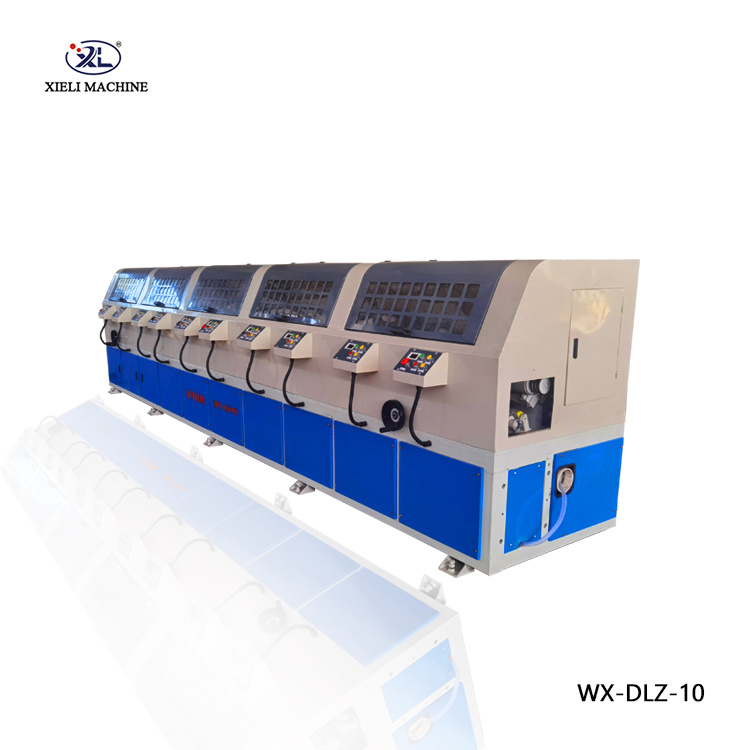
To provide a clearer comparative analysis, below is a table summarizing typical parameters for high-performance tube polishing machines, including the Auto Steel Pipe Tube Outer Wall Polishing Machine, and how they stack up against standard industry offerings. This data aids in making informed procurement decisions, evaluating the return on investment (ROI), and understanding the technical superiority of advanced solutions.
| Parameter | Standard Industry Polisher | Auto Steel Pipe Tube Outer Wall Polishing Machine (Advanced) |
|---|---|---|
| Tube Diameter Range (OD) | Φ10mm - Φ114mm | Φ8mm - Φ219mm |
| Tube Length Range | 1m - 6m | 0.5m - 12m (or custom longer) |
| Number of Polishing Heads | 3-6 heads | 6-12+ heads (Modular options) |
| Main Motor Power (per head) | 5.5 kW - 11 kW | 7.5 kW - 37 kW |
| Processing Speed (m/min) | 0.5 - 5 m/min | 0.8 - 10 m/min (Variable) |
| Achievable Surface Roughness (Ra) | 0.8 µm - 0.4 µm | 0.4 µm - 0.1 µm (Mirror finish possible) |
| Control System | Basic push-button/relay logic | PLC with HMI Touchscreen, Sensor Integration |
| Automation Level | Manual/Semi-automatic loading | Automatic loading/unloading, Real-time monitoring, Adaptive control |
| Energy Efficiency | Standard efficiency motors | High-efficiency motors with VFDs |
| Noise Level (dB) | 80-90 dB | 75-85 dB (with noise reduction measures) |
| Certifications | Basic safety standards | CE, ISO 9001, relevant industry standards (e.g., FDA-compliant materials for food/pharma variants) |
This comparison highlights that while standard polishers offer foundational capabilities, advanced machines like the Auto Steel Pipe Tube Outer Wall Polishing Machine provide superior performance across virtually all metrics, from broader material handling capabilities and higher throughput to finer surface finishes and a higher degree of automation. The investment in an advanced tube polishing machine translates into not just enhanced product quality but also significant improvements in operational efficiency, reduced labor costs, extended component lifespan, and compliance with the most stringent industry regulations, ultimately securing a stronger competitive position in the global market. Furthermore, the integration of data analytics and connectivity in advanced systems allows for continuous process improvement, identifying bottlenecks, optimizing material usage, and performing predictive maintenance, thereby reducing unexpected downtime and maximizing overall equipment effectiveness (OEE). This level of data-driven decision-making provides a significant advantage, moving beyond reactive maintenance to a proactive strategy that ensures sustained peak performance and cost-efficiency over the long term, positioning businesses for future growth and innovation.
Customization and Bespoke Solutions: Tailoring to Specific Industrial Demands
In the diverse landscape of modern manufacturing, a one-size-fits-all approach rarely suffices, especially when dealing with the intricate requirements of specialized industries. Recognizing this, leading tube polishing machine manufacturers, including those behind the Auto Steel Pipe Tube Outer Wall Polishing Machine, place a significant emphasis on offering comprehensive customization and bespoke solutions. This capability allows clients to acquire polishing systems precisely tailored to their unique production workflows, material specifications, volume requirements, and spatial constraints, thereby maximizing efficiency and return on investment. Customization options often begin with the machine's capacity, allowing for adjustments in the processing diameter and length ranges to accommodate unusually large pipes for oil and gas pipelines, or extremely small, intricate tubes for medical devices or aerospace components. For instance, a client requiring polishing for tubes up to 500mm in diameter would necessitate a significantly larger and more robust machine frame, polishing heads with extended reach, and a heavier-duty material handling system than a standard model. Similarly, operations dealing with tubes exceeding 12 meters in length might require modular extensions to the feeding and output conveyors, or even a specialized roller system to prevent sagging and ensure consistent polishing along the entire length.
The number and type of polishing heads can also be customized. While a standard configuration might offer 6-8 heads for a good general-purpose finish, a client in the decorative architectural sector might request 10-12 heads to achieve an ultra-mirror finish (Ra tube polishing machine solution can be designed. Furthermore, specialized features can be incorporated to address unique challenges, such as wet polishing systems with advanced filtration for dust suppression and improved finish quality, or dry polishing systems with highly efficient dust collection for applications where coolant is undesirable. For specific industries, additional modules like in-line cleaning stations (e.g., ultrasonic cleaning or high-pressure washing), drying stations, or even automated passivation units for stainless steel can be integrated into the polishing line to create a comprehensive, single-pass processing solution, minimizing handling and potential recontamination. Manufacturers also offer tailored training programs for client's operational and maintenance staff, ensuring efficient adoption and long-term optimal performance of the customized machine, often complemented by comprehensive technical support and spare parts availability specific to the bespoke configuration. This collaborative approach between client and manufacturer ensures that the resulting polishing system is not just a piece of machinery, but a strategically aligned asset that directly addresses specific operational bottlenecks and elevates overall product quality.
Case Studies and Client Success Stories: Proving Performance in Practice
The true measure of any industrial equipment lies in its proven performance in real-world applications and the tangible benefits it delivers to clients. For a tube polishing machine like the Auto Steel Pipe Tube Outer Wall Polishing Machine, client success stories and meticulously documented case studies serve as powerful testimonials to its capabilities, demonstrating its impact on productivity, quality, and cost-efficiency. These examples highlight how advanced polishing technology addresses specific industrial challenges and contributes to significant operational improvements. Case Study 1: Enhanced Corrosion Resistance in the Petrochemical Sector A major chemical processing plant in the Gulf Coast region faced recurring issues with internal corrosion and fouling in their stainless steel (316L) heat exchanger tubes, leading to frequent shutdowns for cleaning and premature tube replacements. Their existing manual polishing methods were inconsistent and could not achieve the required surface smoothness. After consulting with a leading tube polishing machine manufacturer, they invested in a customized Auto Steel Pipe Tube Outer Wall Polishing Machine, configured with multiple abrasive heads and an integrated post-polishing passivation station. The machine was capable of processing 150mm (6-inch) diameter tubes, 8 meters long, reducing the internal and external surface roughness (Ra) from an average of 1.6 µm to a consistent 0.4 µm. Results: Within six months of implementation, the plant reported a 40% reduction in fouling rates, leading to a 25% increase in operational uptime for the heat exchangers. The enhanced surface finish also contributed to a 15% reduction in cleaning chemical consumption due to easier cleanability. Over two years, the lifespan of the polished tubes increased by an estimated 30%, significantly reducing material and maintenance costs. The precise surface finish also reduced adherence of aggressive media, thereby mitigating localized corrosion mechanisms. The client noted that the machine's automation also reduced labor costs by 70% compared to their previous manual methods, and the consistent quality ensured compliance with increasingly stringent industry standards for material handling. This demonstrable improvement in both operational efficiency and asset longevity solidified the value proposition of investing in high-precision tube polishing technology.
Case Study 2: Achieving Ultra-High Purity for Pharmaceutical Manufacturing A pharmaceutical company specializing in aseptic drug production required exceptionally smooth and crevice-free stainless steel tubing for their new cleanroom fluid transfer lines. The existing vendor's tubes, while meeting basic material specifications, often had residual surface imperfections that could harbor microbial contaminants, posing a significant risk to product sterility. The company procured a specialized Auto Steel Pipe Tube Outer Wall Polishing Machine, designed for sanitary applications, which included advanced features like an integrated in-line cleaning and passivation module, and stringent particle filtration for the polishing lubricants. This machine was calibrated to achieve an internal and external surface roughness of Ra 0.25 µm, verified by a third-party metrology lab. Results: The implementation of the new tube polishing machine resulted in a 99% reduction in bioburden counts on the tube surfaces during post-processing microbial testing, drastically improving the sterility assurance levels. The consistently smooth surface allowed for more effective Clean-in-Place (CIP) and Sterilize-in-Place (SIP) cycles, reducing water and chemical usage by 20% and shortening cleaning cycle times by 15%. This not only lowered operational costs but also enhanced production throughput. Furthermore, the company was able to achieve rapid validation and approval from regulatory bodies (e.g., FDA), accelerating time-to-market for new drug products due to the documented superior hygiene of their fluid transfer systems. The automation of the polishing process also minimized human contact, further reducing contamination risks inherent in manual handling, which is a critical factor in pharmaceutical environments. The system's ability to maintain consistent quality across large batches of tubes (over 10,000 meters per month) ensured scalability for future production demands while adhering to the highest cGMP standards. These case studies underscore the transformative impact of investing in state-of-the-art tube polishing technology, demonstrating how precise surface finishing can drive significant improvements in product quality, operational efficiency, and overall business competitiveness across diverse industrial sectors. The tangible data and quantified benefits provide compelling evidence for decision-makers considering such a strategic investment.
After-Sales Support, Warranty, and Trust-Building: Our Commitment to Your Success
Investing in a sophisticated industrial asset like the Auto Steel Pipe Tube Outer Wall Polishing Machine is a strategic decision that extends beyond the initial purchase. It represents a long-term partnership with the tube polishing machine manufacturer, and the quality of after-sales support, warranty provisions, and customer service plays a pivotal role in ensuring the sustained success and optimal performance of the equipment throughout its lifecycle. A reputable manufacturer understands that continuous operational readiness is paramount for a B2B client's productivity. Our commitment begins with transparent communication regarding the delivery cycle. Typically, the lead time for an Auto Steel Pipe Tube Outer Wall Polishing Machine, depending on the level of customization and current production schedule, ranges from 8 to 16 weeks from order confirmation to factory acceptance test (FAT). This period accounts for meticulous material procurement, precision manufacturing, assembly, and rigorous internal quality checks. During this phase, clients receive regular updates on production milestones, ensuring complete transparency and enabling them to plan their facility readiness accordingly. Upon completion, a comprehensive Factory Acceptance Test (FAT) is conducted at our facility, where clients or their appointed representatives are invited to witness the machine's operation, verify all specifications, and approve the equipment before shipment. This crucial step ensures that the machine meets all agreed-upon performance criteria and quality standards prior to dispatch.
Following successful FAT, we meticulously prepare the machine for shipment, ensuring robust packaging and secure transportation to prevent any damage during transit. Upon arrival at the client's site, our commitment continues with on-site installation and commissioning services. A team of highly skilled engineers and technicians is deployed to supervise the setup, electrical and pneumatic connections, and initial calibration of the tube polishing machine. This ensures that the machine is installed correctly, integrated seamlessly into the existing production line, and brought to full operational readiness. Concurrently, comprehensive operator training is provided, covering daily operation, routine maintenance, troubleshooting, and safety protocols. This hands-on training empowers the client's personnel to confidently and efficiently manage the machine, maximizing its potential. Our warranty commitment typically includes a standard 12 to 24-month warranty period from the date of commissioning or shipment (whichever comes first), covering parts and labor for any manufacturing defects or malfunctions under normal operating conditions. This warranty provides clients with peace of mind and demonstrates our confidence in the quality and reliability of our engineering. Beyond the warranty period, we offer flexible extended warranty programs and service contracts tailored to client needs, ensuring long-term protection and support.
Our dedication to customer support is unwavering, offering multiple channels for assistance. Our technical support hotline and online support portal provide rapid access to our expert team for immediate troubleshooting, technical advice, and remote diagnostics. For complex issues requiring physical presence, our global network of field service engineers is ready for on-site service and repairs, minimizing downtime and ensuring quick resolution. We maintain a comprehensive inventory of spare parts at our centralized warehouse, guaranteeing timely availability of critical components to prevent extended interruptions. For optimal performance and longevity, we also offer preventive maintenance programs and annual inspections, helping clients identify and address potential issues before they escalate, thereby extending the machine's operational life and optimizing its Total Cost of Ownership (TCO). To further enhance trustworthiness and transparency, we provide a Frequently Asked Questions (FAQ) module that addresses common inquiries related to machine operation, maintenance, and specific application challenges. This resource, continuously updated based on client feedback and technical developments, serves as a valuable self-help tool. Our strong foundation in quality management, evidenced by ISO 9001 certification, underpins all aspects of our service delivery. This comprehensive after-sales ecosystem underscores our commitment to not just selling a machine, but building a lasting partnership based on trust, reliability, and mutual success, ensuring that your investment in a pipe tube polisher continues to deliver value for years to come.
Industry Outlook and Future Trends: Shaping the Evolution of Tube Polishing
The landscape of industrial manufacturing is perpetually evolving, driven by technological advancements, increasing demands for precision, and a growing emphasis on sustainability and automation. The future of tube polishing machine technology is poised for significant innovation, reflecting these broader industry trends and pushing the boundaries of what is achievable in surface finishing. One of the most prominent trends is the relentless drive towards enhanced automation and artificial intelligence (AI) integration. Future polishing machines will move beyond programmable logic controllers (PLCs) to incorporate advanced AI and machine learning algorithms that can analyze real-time sensor data from cameras, laser profilometers, and force sensors. These AI systems will not only adapt polishing parameters (e.g., pressure, speed, oscillation patterns) dynamically to compensate for variations in material hardness, tube geometry, or abrasive wear but will also learn from past operations to predict optimal polishing recipes for new materials or desired finishes. This adaptive control will lead to even greater consistency, reduce material waste, and significantly extend the lifespan of consumables by optimizing their usage, thereby lowering operational costs. The integration of collaborative robots (cobots) for automated loading, unloading, and inspection will further minimize human intervention, enhancing safety and increasing throughput.
Another critical trend is the focus on sustainability and environmental responsibility. Future pipe tube polisher designs will prioritize energy efficiency through the use of ultra-high-efficiency motors, regenerative braking systems, and smart power management. Innovations in abrasive materials will lead to longer-lasting, more environmentally friendly options, reducing the generation of waste. Advanced filtration and recycling systems for coolants and polishing slurries will minimize water consumption and chemical waste, potentially enabling closed-loop processing. Furthermore, sophisticated dust collection and air purification systems will ensure cleaner work environments and compliance with increasingly strict environmental regulations, moving towards near-zero emissions. The concept of Industry 4.0 and the Industrial Internet of Things (IIoT) will deeply permeate tube polishing operations. Machines will be fully networked, collecting vast amounts of operational data (e.g., throughput, energy consumption, abrasive wear, finished surface quality). This data will be analyzed in real-time by cloud-based platforms, providing manufacturers with actionable insights for predictive maintenance, remote diagnostics, supply chain optimization, and overall equipment effectiveness (OEE) improvements. This connectivity will also enable remote monitoring and control, allowing engineers to supervise operations and intervene from anywhere in the world, ensuring continuous uptime and optimized performance. The ability to track each tube through the polishing process, logging its parameters and final surface quality, will also enhance traceability, a crucial requirement in regulated industries like aerospace and medical.
Advanced material processing capabilities will also drive innovation. As industries increasingly adopt new alloys and composite materials with unique properties, polishing machines will need to evolve to handle these challenging materials effectively without compromising surface integrity. This will involve the development of novel abrasive media, specialized polishing techniques (e.g., electro-polishing, chemical mechanical polishing, or even plasma polishing for specific applications), and more sophisticated control over temperature and pressure during the polishing process. Miniaturization and precision will also become more important, especially for industries producing micro-tubing for medical implants, micro-electronics, or advanced sensor applications, requiring even finer control over surface finish down to nanometer scales. Finally, the growing emphasis on customization and modularity will continue to shape machine design. Manufacturers will offer highly configurable systems that can be easily adapted to changing production demands, allowing clients to add or remove polishing stations, integrate different types of finishing processes, or reconfigure the material handling system with minimal effort and investment. This flexibility ensures that the tube polishing machine remains a long-term, adaptable asset within a dynamic manufacturing environment. These trends collectively point towards a future where tube polishing machines are not just mechanical devices but intelligent, interconnected, and highly adaptable systems, critical for achieving the next level of precision, efficiency, and sustainability in industrial manufacturing.
References and Further Reading
For those interested in delving deeper into the technical aspects and industry standards related to tube polishing and surface finishing, the following resources provide valuable insights:
- ASM International: Provides extensive technical information on materials, processing, and surface engineering. Their Handbooks, particularly on "Surface Engineering" and "Mechanical Properties and Performance of Engineering Materials," offer detailed insights into the science behind polishing and its effects on material properties. https://www.asminternational.org/
- ISO (International Organization for Standardization): For standards on surface texture (e.g., ISO 4287 for surface roughness parameters), quality management (ISO 9001), and safety of machinery (ISO 12100). https://www.iso.org/home.html
- ASME Bioprocessing Equipment (BPE) Standard: Essential for understanding surface finish requirements in the pharmaceutical and biotech industries. https://www.asme.org/codes-standards/find-codes-standards/bpe-bioprocessing-equipment
- Industrial Polishing Forum Discussions: Online communities often host discussions on practical challenges, solutions, and emerging technologies in industrial polishing. Examples can be found on platforms like LinkedIn groups for "Metal Finishing" or "Surface Treatment Technologies," or specialized engineering forums. (Note: Direct forum links are dynamic and may vary, search for relevant groups or forums.)
- "Principles of Abrasive Processing" by M.C. Shaw: A seminal academic work providing fundamental principles of grinding and polishing. Available through university libraries or technical book retailers.

